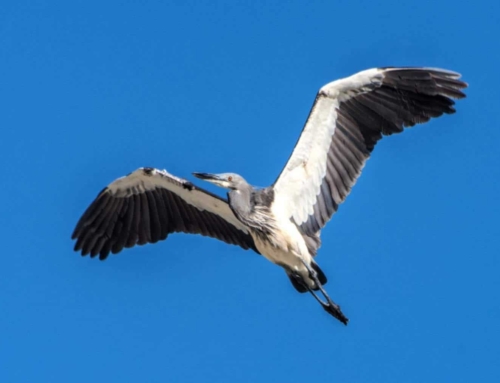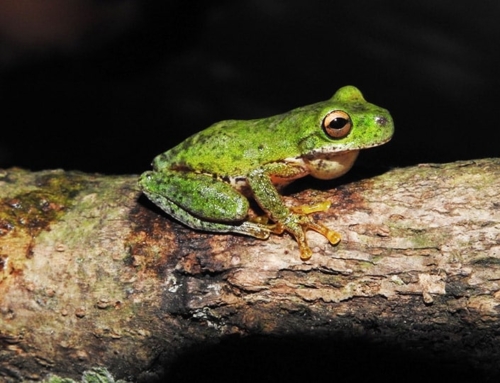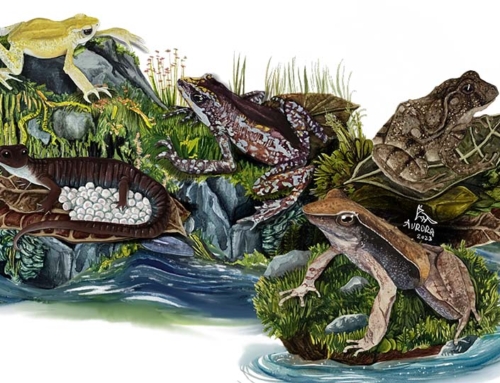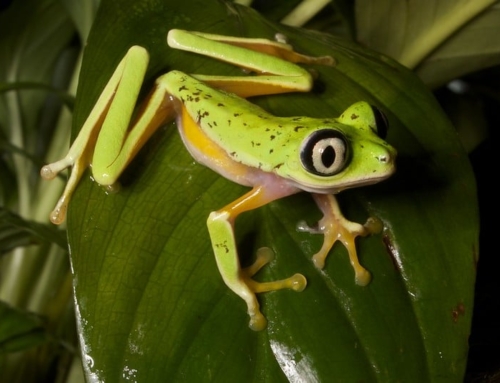I first met George Rabb at Royal Botanic Gardens, Kew, in October 1985 when I was interviewed by an intimidating panel of four men and one woman for the position of Species Programme Officer at The International Union for Conservation of Nature (IUCN) headquarters in Gland, Switzerland.

George Rabb (and Archey). Image: Phil Bishop
George was on the panel – I don’t remember much of the interview, except that I got the job, and IUCN has defined my career ever since. At the IUCN World Conservation Congress in Honolulu in September 2016, 31 years later, at the goodbye party to mark the end of my 8 years as Species Survival Commission (SSC) Chair, George gave the final speech and, in addition to saying some kind words about me, told those present: “I hired Simon!”, underlying his constant presence to me beginning with that 1985 interview.
George was already a dominant force on the SSC Steering Committee (SC) by the time I joined IUCN. I attended my first Steering Committee meeting in March 1986, and that was when I really started to get to know George, with the first of our many one-to-one in-depth conversations. His extraordinary intellect, his deep ethical commitment to conservation, and his breadth of interests marked him as an influential force to be reckoned with. Soon after, Wayne King resigned as the SSC Deputy Chair, and George was appointed to take his place. When Gren Lucas resigned as SSC Chair in August 1989, George became Chair, and served until 1996.
George assumed his leadership of the SSC while Martin Holdgate was Director General of IUCN. The two men were similar in some respects – very sharp intellects, huge knowledge and commitment, and also both to some extent a little traditional in their mannerisms. They clearly had great respect for each other, and the SSC’s standing within the wider IUCN family grew enormously under George’s leadership. George brought about many changes during his time as SSC Chair. He brought many new and younger people from across the world on to the Steering Committee, improved its gender balance, and established many new Specialist Groups (SG). Some of the most active SGs in SSC today, such as the Shark, Iguana and Invasive Species SGs, were established under George’s leadership.
George was not a typical leader. In many ways he was a shy and self-effacing man. He never sought to be the centre of attention and always gave great credit to others. But when a topic arose about which he cared deeply, he could speak with passion and conviction. George endeared himself to SSC members across the globe with his straightforward, uncomplicated commitment to saving the world’s species and natural places. He became the unofficial leader of the zoo community within IUCN and was a pioneer of the movement to bring zoos more fully into conservation, working closely alongside the likes of Bill Conway, Ulysses Seal and David Jones. George used to go to the IUCN Congress having collected a large number of proxy votes from across the zoo community. In the days before IUCN introduced electronic voting, George became famous for holding up a fistful of ballot papers whenever a vote was taken! But although he played the IUCN political game, George was never a politician in a scheming or tactical sense. He avoided other people’s controversies and was reluctant to trade votes to get his own way. George was more of a conviction politician, fighting for things he believed to be morally right and opposing things that he believed to be wrong. He also had courage. A classic example arose in 1995 when some of the US Government’s most important conservation funding mechanisms were under serious threat of being reduced, or even closed. George invited the then Speaker of the House of Representatives, Newt Gingrich, to Brookfield Zoo, and the resulting meeting led to the Speaker adopting a pro-conservation stance and defending and saving these funding streams.
George knew that his effectiveness grew from surrounding himself with top-calibre people. Compared with any SSC Chair before him, George built up a significant support team at the Brookfield Zoo, composed of people such as Tim Sullivan, Susan Tressler, Elizabeth McCance, Mena Boulanger, Maria Sadowski and Craig Pugh. This was made possible by the generous support of the Chicago Zoological Society, a recognition of the global importance of the conservation work that George was leading. George and his team worked in seamless unity with the IUCN Secretariat Species Programme team that I was leading at the time. A few weeks after George took over as SSC Chair, the great Sir Peter Scott, also a former SSC Chair, passed away. Sir Peter’s friend, Sultan Qaboos of Oman, decided to give USD 1.5 million to SSC in Sir Peter’s honour. George and his team used the Sir Peter Scott Fund to provide highly strategic grants to SSC SGs focused especially on action planning, thus starting the process to make the SGs much more proactive, as we see today.
During his tenure as SSC Chair, George typically visited Switzerland at least twice a year on IUCN business. He often stayed with my family and me, and we enjoyed the evenings together, as he unwound from the affairs of IUCN by playing with my little daughter Claire. He often brought her soft toy animals from the Brookfield Zoo shop. I often wondered how much sadness George and Mary might have felt at not having children of their own. But as we all know, George was a very private person and avoided talking about himself. George and I shared a love for classical music. He once took me and some of his SSC team to a Chicago Symphony Orchestra concert. And he gave me many classical CDs over the years; one by Alfred Deller conducting choral music by Purcell stands out (George noted how a recording from the 1950s could have sound quality just as good as modern digital recordings if the producer knew how to position the microphones properly – an example of George’s broad interests and knowledge!). I also remember in one conversation when George and I had a meeting of minds in agreeing that the greatest piece of music ever written by a teenager is Mendelssohn’s Octet!
George pursued many conservation passions during his long life. He loved the Okapi, and this led to an abiding interest in the Democratic Republic of the Congo (DRC) and the research station at Epulu. When all the captive animals at the station were killed in 2012 during the terrible civil strife in that suffering country, George was heartbroken, but characteristically also took the initiative in generating a constructive response. He got a late emergency motion on the Okapi submitted and adopted at the 2012 IUCN Congress, calling for urgent assistance for Okapi conservation. The publication of the SSC Okapi Action Plan in 2016, a joint initiative with the DRC Government, followed on from this call. George became great friends with the long-term head of conservation in the DRC, Dr Mankoto ma Mbaelele. It was heart-warming to witness them meeting each again at the IUCN Congress in 2012 after many years. George was also heavily involved in the SSC Conservation Breeding Specialist Group (CBSG). He was a close advisor and supporter of Ulie Seal, CBSG’s founding chair. Most significantly George recruited the leading population geneticist, Bob Lacy, to work at Brookfield Zoo, and made him available to the CBSG. Bob wrote the Population and Habitat Viability Analysis (PHVA) software, Vortex, which became the basis for the CBSG’s many PHVA workshops held in many parts of the world, and is still widely used today. Bob later became CBSG Chair following Ulie’s death. George was also involved in other organizations. He was a board member of the Center for Humans and Nature, Defenders of Wildlife, and many others. He was a prime mover of the Chicago Wilderness initiative, showing his ability to focus on both the local and the global. His earlier natural history exploits have faded with time, but remain remarkable. For example, he discovered several species of salamander in Mexico in the 1950s, published a paper on wolf social behaviour in 1967, and was one of the last people to see Bachman’s Warbler in the field. He had an abiding interest in environmental ethics and was heavily involved in the IUCN World Commission on Environmental Law’s Ethics Specialist Group. He was a major contributor to the Draft International Covenant on Environment and Development. And in the past few years he was part of the movement to establish a ‘World Organization on the Environment’.
Despite all of these interests and achievements, George’s largest single contribution was to amphibian conservation. It is no exaggeration to say that George was the founder of the amphibian conservation movement. As noted above, George was already working on amphibians back in the 1950s. But things suddenly changed at the First World Herpetological Congress in 1989, when the alarm bell of unexplained and dramatic amphibian declines and extinctions taking place around the world was first sounded. This could have resulted in a shocked scientific world with no follow-up action. However, George had the vision and leadership to turn the alarm bell into a clarion call to mobilize action for amphibian conservation and research. As a direct result, the global amphibian conservation movement started to develop, focused on both understanding the science and the scale of the problem, and then working on conservation solutions.
The very first step was the formation of the Declining Amphibian Populations Task Force (DAPTF) within IUCN SSC, and everything followed from that. The DAPTF demonstrated conclusively that amphibian declines were real phenomena, and eventually the underlying cause of many of these declines, a fungal pathogen, was discovered. George was involved in all of the major steps that subsequently took place: the Global Amphibian Assessment in 2004 (which I was privileged to lead and showed the global extent of the crisis); the founding of Amphibian Ark in 2005 which started the mobilization of zoos to give high priority to ex situ amphibian conservation; the Amphibian Conservation Summit in 2005 (and subsequent mini-summit in 2009); the transformation of the DAPTF into the SSC Amphibian SG (2005), the Amphibian Conservation Action Plan (2006 and subsequently updated); and the founding of the Amphibian Survival Alliance (2010) which has become the umbrella body for amphibian conservation. Nobody else was involved at every stage in the way that George was. He was without doubt the founder and “spiritual” leader of the amphibian conservation movement. It is for this reason that an Amphibian Conservation Fund will soon be launched in George’s honour, something that George agreed to in his usual self-deprecatory manner shortly before his last illness.
What is less widely known is that as well as being the driving force behind the initial establishment of Amphibian Ark and the Amphibian Survival Alliance, he was also a major and faithful donor to both of them, but characteristically had no interest in having this be widely known. Although George died knowing that the amphibian crisis was far from solved, I hope that he was able to draw some pleasure from the rapid growth of amphibian conservation globally as civil society and academia respond to the crisis. I believe that this would not have happened without George’s initial leadership.
Another remarkable characteristic of George was his ability to stay on top of the scientific literature, right up until the end. He was constantly looking forward to the next challenges, and always pushed the Amphibian Survival Alliance to be proactive and ready for the next change. In the last few months of his life he became a strong advocate of exploring the potential of new genetic technology to develop solutions in the fight against amphibian disease. As Phil Bishop wrote recently, he was always ahead of his time. While George was Director at Brookfield Zoo, his wife Mary worked in the zoo’s library. She systematically made photocopies of all the scientific papers that she thought he should be reading, and this enabled him to stay current. Later on after his retirement from the zoo, Mary’s health started to deteriorate and George devoted more and more of his life to being her carer. As a result, he had much less time for his conservation activities. When she passed away he was devastated and I, along with many others, wondered how he would cope. But instead he threw himself headlong into a whole range of activities in all the organizations named above. He was perhaps the most faithful contributor to the monthly conference calls of the Amphibian Survival Alliance’s Global Council. He was scheduled to come to Canterbury in June this year to take part in the annual meeting of the Global Council but had to cancel. But when he did not show up to participate remotely, his close friend Anne Baker from Amphibian Ark and I knew that this was very uncharacteristic and that something was seriously wrong. Unfortunately we were right. Over the subsequent weeks, George’s faithful office team kept us updated. Sometimes we were more hopeful; other times not. When the news we were all dreading finally came there was much sadness all across the world from the thousands of people whose lives had been touched by George.
George was always a generous man and this showed itself in many ways. He would frequently send well-chosen scientific papers to his many acolytes to make sure that we were focusing on what he saw as the key issues. And whenever a group of people went out for a meal, there was an unstated and unnegotiable rule that George would pay! In 2009 the SSC SC decided to establish the George Rabb Award for Conservation Innovation. George immediately decided to fund the award at USD 5,000 per recipient. There have been four recipients to date: Bob Lacy; Resit Akcakaya; Penny Langhammer; and Mike Hoffmann.
Probably more people would describe George as their mentor than anyone else I can imagine. I am proud to be one of them. But strangely enough, I don’t think George ever set out to be an intentional mentor of anyone. He just became a mentor by his example, his ethics, his commitment, his constant challenging of us, and his kindness. George was not always easy on his mentees. He could be irascible and impatient at times, but it was all for the greater conservation course. Despite being a very private person, he became close to many of us. I certainly did not agree with him on everything, but on the fundamental conservation issues we were of one mind. It is hard to imagine life now without George. He is irreplaceable, but he also leaves a tremendous legacy.
Thank you George for being there for me every step of the way these past 32 years. I will miss you hugely but count myself as hugely blessed by having you as part of my life.





